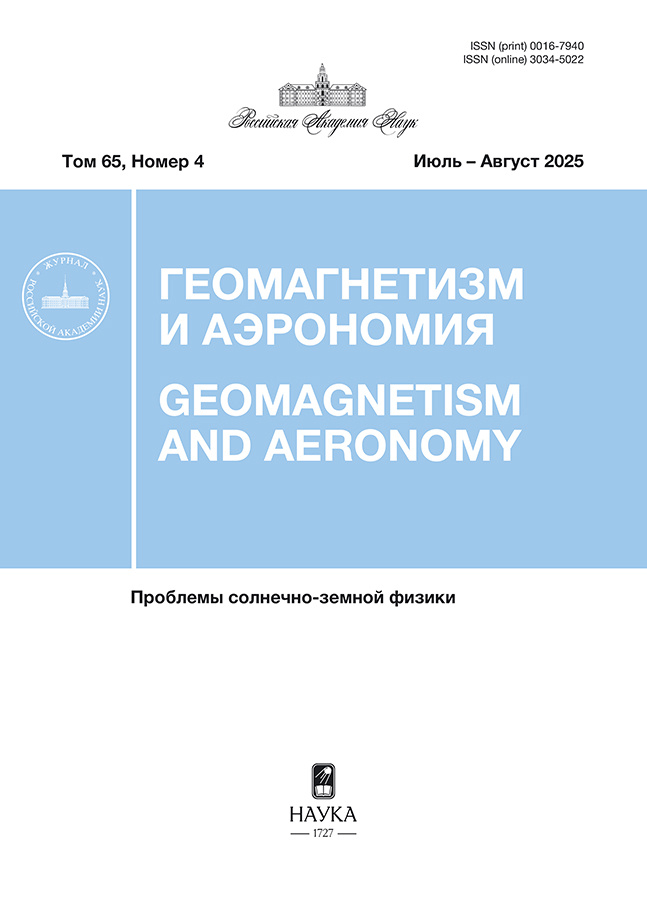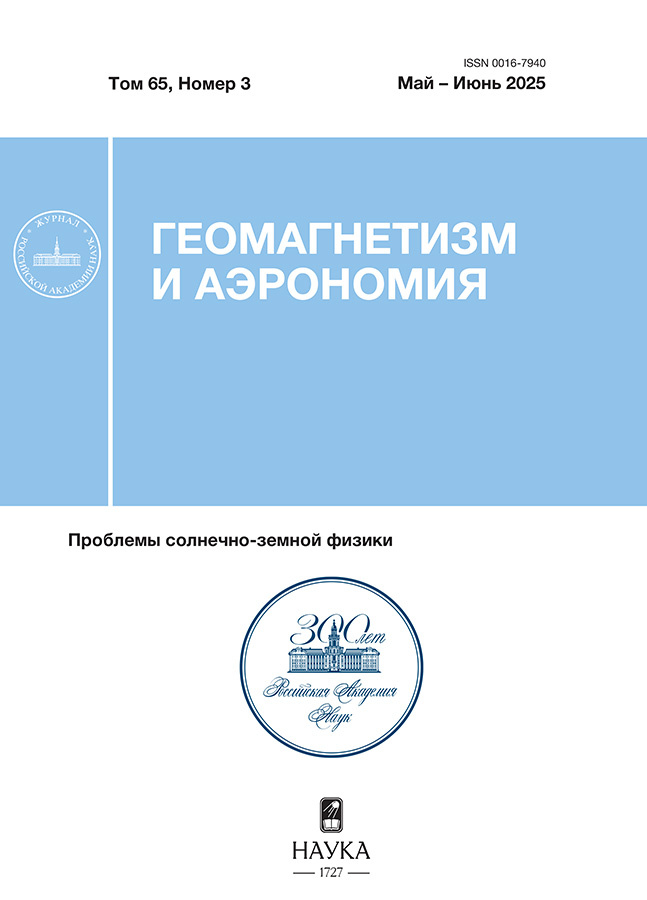New Possibilities of Oblique Ionospheric Sensing Using Phased Array Antennas
- Authors: Moiseev I.A.1, Suvorova Z.V.2, Nikishov V.V.3, Nikishov A.V.3, Mingalev I.V.2, Shubin V.N.4, Merzly A.M.1, Yanakov A.T.1
-
Affiliations:
- Space Research Institute of the Russian Academy of Sciences
- Polar Geophysical Institute
- Elanor Experimental Design Bureau
- Pushkov Institute of Terrestrial Magnetism, Ionosphere and Radio Wave Propagation of the Russian Academy of Sciences
- Issue: Vol 65, No 3 (2025)
- Pages: 370-383
- Section: Articles
- URL: https://snv63.ru/0016-7940/article/view/687059
- DOI: https://doi.org/10.31857/S0016794025030089
- EDN: https://elibrary.ru/ESSPVC
- ID: 687059
Cite item
Abstract
Additional possibilities of the method of oblique ionospheric sounding with the measurement of the angle of location and azimuth of the radial trajectories of short-wave radio signals using receiving and transmitting phased array annular arrays with a software-controlled directional pattern are discussed. For a mid-latitude radio path for four days, experimental measurements at the receiving point of the radio path of the angles of arrival of modes of single-jump propagation of radio waves were compared with the results of calculations of radial trajectories for this radio path, performed using the empirical GDMI ionosphere model developed in IZMIRAN. It is shown that in the morning hours from 06:00 UT to 07:30 UT there is a good correspondence between the measured and calculated arrival angles, and in the daytime, to achieve the same correspondence, a slight correction of the distributions of ionospheric plasma parameters calculated using the GDMI model is required.
Full Text
About the authors
I. A. Moiseev
Space Research Institute of the Russian Academy of Sciences
Author for correspondence.
Email: moiseeviaiki@yandex.ru
Russian Federation, Moscow
Z. V. Suvorova
Polar Geophysical Institute
Email: moiseeviaiki@yandex.ru
Russian Federation, Murmansk
V. V. Nikishov
Elanor Experimental Design Bureau
Email: moiseeviaiki@yandex.ru
Russian Federation, Moscow
A. V. Nikishov
Elanor Experimental Design Bureau
Email: moiseeviaiki@yandex.ru
Russian Federation, Moscow
I. V. Mingalev
Polar Geophysical Institute
Email: moiseeviaiki@yandex.ru
Russian Federation, Murmansk
V. N. Shubin
Pushkov Institute of Terrestrial Magnetism, Ionosphere and Radio Wave Propagation of the Russian Academy of Sciences
Email: moiseeviaiki@yandex.ru
Russian Federation, Troitsk
A. M. Merzly
Space Research Institute of the Russian Academy of Sciences
Email: moiseeviaiki@yandex.ru
Russian Federation, Moscow
A. T. Yanakov
Space Research Institute of the Russian Academy of Sciences
Email: moiseeviaiki@yandex.ru
Russian Federation, Moscow
References
- Андреев М.Ю., Благовещенский Д.В., Выставной В.М., Мингалев В.С., Мингалева Г.И. Интерпретация экспериментальных данных распространения коротких радиоволн на трассе Санкт-Петербург – арх. Шпицберген // Геомагнетизм и аэрономия. Т. 47. № 4. С. 534–542. 2007a.
- Андреев М.Ю., Мингалева Г.И., Мингалев В.С. Численное моделирование структуры высокоширотного ионосферного слоя F и прохождения через него коротких радиоволн в меридиональном направлении // Геомагнетизм и аэрономия. Т. 47. № 4. С. 518–527. 2007б.
- Брюнелли Б.Е., Намгаладзе А.А. Физика ионосферы. М.: Наука, 528 с. 1988.
- Вертоградов Г.Г., Урядов В.П., Вертоградова Е.Г., Понятов А.А. Сверхдальнее зондирование ионосферного канала с помощью ионозонда/пеленгатора с линейной частотной модуляцией сигнала // Изв. вузов. Радиофизика. Т. 53. № 3. С. 176–187. 2010.
- Вертоградов Г.Г., Урядов В.П., Вертоградов В.Г., Вертоградова Е.Г., Кубатко С.В. Ионозонд-радиопеленгатор с линейной частотной модуляцией сигнала - новый инструмент для исследований ионосферы и распространения радиоволн сигнала // Изв. вузов. Радиофизика. Т. 56. № 5. С. 287–306. 2013.
- Вертоградов Г.Г., Урядов В.П., Скляревский М.С., Валов В.А. Наклонное зондирование ионосферы с помощью ионозонда-радиопеленгатора с линейной частотной модуляцией сигнала // Изв. вузов. Радиофизика. Т. 59. № 11. С. 991–1003. 2016.
- Кравцов Ю.А., Орлов Ю.И. Геометрическая оптика неоднородных сред. М.: Наука, 304 c. 1980.
- Крашенинников И.В., Шубин В.Н. Частотная зависимость энергетических параметров волнового поля на предельной дальности односкачкового распространения радиоволн в условиях низкой солнечной активности // Геомагнетизм и аэрономия. Т. 60. № 2. C. 220–228. 2020. https://doi.org/10.31857/S001679402002008X
- Крашенинников И.В., Егоров И.Б. Формирование комбинированных модов в ионосферном прохождении радиоволн // Геомагнетизм и аэрономия. Т. 45. № 2. С. 241–244. 2005.
- Крашенинников И.В., Павлова Н.М., Ситнов Ю.С. Модель IRI в задаче прогнозирования ионосферного прохождения радиоволн в условиях высокой солнечной активности // Геомагнетизм и аэрономия. Т. 57. № 6. С. 774–782. 2017. https://doi.org/10.7868/S0016794017060050
- Крашенинников И.В., Гивишвили Г.В., Стаханова И.Г. Оценка критической частоты в задаче радиопросвечивания ионосферы с высокоорбитальных космических аппаратов в арктическом регионе // Геомагнетизм и аэрономия. Т. 58. № 5. С. 669–675. 2018. https://doi.org/10.1134/S0016794018050097
- Людвиг В.А., Никишов В.В. Пассивная локация и противодействие системам наведения высокоточного оружия. М.: ЛЕНАНД, 256 с. 2021.
- Мингалев И.В., Суворова З.В., Шубин В.Н., Мерзлый А.М., Тихонов В.В., Талалаев А.Б., Мингалев В.С. Отличия прогнозов условий КВ-радиосвязи между передатчиком на средних широтах и приемником в арктическом регионе при использовании различных эмпирических моделей ионосферы // Геомагнетизм и аэрономия. Т. 61. № 4. С. 506–519. 2021. https://doi.org/10.31857/S001679402104009X
- Никишов Д.В., Никишов В.В. Система декаметровой связи через ионосферу / Патент Российской Федерации на изобретение № 2680312 от 20.02.2019 г.
- Шубин В.Н. Глобальная эмпирическая модель критической частоты F2-слоя ионосферы для спокойных геомагнитных условий // Геомагнетизм и аэрономия. Т. 57. № 4. C. 450–462. 2017. https://doi.org/10.7868/S0016794017040186
- Budden K.G. The propagation of radio waves. Cambridge: Cambridge University Press. 669 p. 1985.
- Shubin V.N. Global median model of the F2-layer peak height based on ionospheric radio-occultation and ground-based Digisonde observations // Adv. Space Res. V. 56. № 2. P. 916–928. 2015. https://doi.org/10.1016/j.asr.2015.05.029
- Shubin V.N., Karpachev A.T., Tsybulya K.G. Global model of the F2 layer peak height for low solar activity based on GPS radio-occultation data // J. Atmos. Sol.-Terr. Phy. V. 104. P. 106–115. 2013. https://doi.org/10.1016/j.jastp.2013.08.024
Supplementary files













